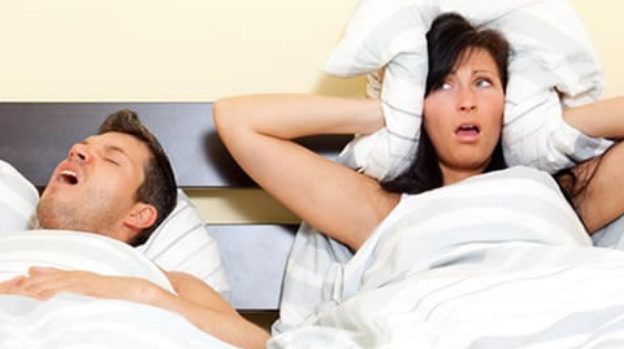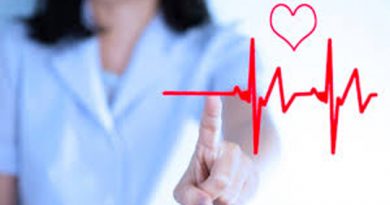Sleep apnea
Sleep apnea, also spelled sleep apnoea, is a sleep disorder characterized by pauses in breathing or periods of shallow breathing during sleep. Each pause can last for a few seconds to several minutes and they happen many times a night. In the most common form, this follows loud snoring. There may be a choking or snorting sound as breathing resumes. As it disrupts normal sleep, those affected are often sleepy or tired during the day. In children it may cause problems in school or hyperactivity.
There are three forms of sleep apnea: obstructive (OSA), central (CSA), and a combination of the two called mixed. OSA is the most common form. Risk factors for OSA include being overweight, a family history of the condition, allergies, and enlarged tonsils. In OSA, breathing is interrupted by a blockage of airflow, while in CSA breathing stops due to a lack of effort to breathe. People with sleep apnea are often not aware they have it. Often it is first observed by a family member. Sleep apnea is often diagnosed with an overnight sleep study. For a diagnosis of sleep apnea, more than five episodes an hour must occur.
Treatment may include lifestyle changes, mouthpieces, breathing devices, and surgery. Lifestyle changes may include avoiding alcohol, weight loss, stopping smoking, and sleeping on their side. Breathing devices include the use of a CPAP machine. Without treatment sleep apnea may increase the risk of heart attack, stroke, diabetes, heart failure, irregular heartbeat, obesity, and motor vehicle collisions.
OSA affects 1-6% of adults and 2% of children. It affects males about twice as often as females.While people at any age can be affected it occurs most commonly among those 55 to 60 years old.Central sleep apnea affects less than one percent of people.A type of central sleep apnea was described in the German myth of Ondine’s curse where when asleep the person would forget to breathe.
Signs and symptoms
People with sleep apnea have problems with excessive daytime sleepiness (EDS), impaired alertness, and vision problems. OSA may increase risk for driving accidents and work-related accidents. If OSA is not treated, people are at increased risk of other health problems, such as diabetes. Even death could occur from untreated OSA due to lack of oxygen to the body. Moreover, people are examined using “standard test batteries” in order to further identify parts of the brain that may be adversely affected by sleep apnea, including those that govern:
- “executive functioning”, the way the person plans and initiates tasks
- paying attention, working effectively and processing information when in a waking state
- using memory and learning.
Due to the disruption in daytime cognitive state, behavioral effects may also be present. These can include moodiness, belligerence, as well as a decrease in attentiveness and energy.Another symptom related to sleep apnea is sleep paralysis, the fear of which can sometimes lead to insomnia. These effects may become intractable, leading to depression.
There is also evidence that the risk of diabetes among those with moderate or severe sleep apnea is higher. There is also increasing evidence that sleep apnea may also lead to liver function impairment, particularly fatty liver diseases (see steatosis). Finally, because there are many factors that could lead to some of the effects previously listed, some people are not aware that they have sleep apnea and are either misdiagnosed, or just ignore the symptoms altogether.
Risk factors
Sleep apnea can affect people regardless of sex, race, or age. However, risk factors include:
- being male
- excessive weight
- an age above 40
- large neck size (greater than 16–17 inches)
- enlarged tonsils or tongue
- small jaw bone
- gastroesophageal reflux
- allergies
- sinus problems
- a family history of sleep apnea
- deviated septum
Alcohol, sedatives and tranquilizers may also promote sleep apnea by relaxing throat muscles. Smokers have sleep apnea at three times the rate of people who have never smoked.
Central sleep apnea is more often associated with any of the following risk factors:
- being male
- being older than 65 years
- having heart disorders such as atrial fibrillation or atrial septal defects such as PFO
- stroke
High blood pressure is very common in people with sleep apnea.
Mechanism
When breathing is paused, carbon dioxide builds up in the bloodstream. Chemoreceptors in the blood stream note the high carbon dioxide levels. The brain is signaled to wake the person sleeping and breathe in air. Breathing normally will restore oxygen levels and the person will fall asleep again.
Diagnosis
Sleep apnea may be diagnosed by the evaluation of symptoms, risk factors and observation, (e.g., excessive daytime sleepiness and fatigue) but the gold standard for diagnosis is a formal sleep study (polysomnography, or sometimes reduced channels home based test). A study can establish reliable indices of the disorder, derived from the number and type of event per hour of sleep (Apnea Hypopnea Index (AHI), or Respiratory Disturbance Index (RDI)), associated to a formal threshold, above which a patient is considered as suffering from sleep apnea, and the severity of their sleep apnea can then be quantified. Mild OSA (Obstructive Sleep Apneas) ranges from 5 to 14.9 events per hour, moderate OSA falls in the range of 15–29.9 events per hour, and severe OSA would be a patient having over 30 events per hour.
Despite this medical consensus, the variety of apneic events (e.g., hypopnea vs apnea, central vs obstructive), the variability of patients’ physiologies, and the inherent shortcomings and variability of equipment and methods, this field is subject to debate. Within this context, the definition of an event depends on several factors (e.g., patient’s age) and account for this variability through a multi-criteria decision rule described in several, sometimes conflicting, guidelines. One example of a commonly adopted definition of an apnea (for an adult) includes a minimum 10 second interval between breaths, with either a neurological arousal (a 3-second or greater shift in EEG frequency, measured at C3, C4, O1, or O2) or a blood oxygen desaturation of 3–4% or greater, or both arousal and desaturation.
Oximetry
Oximetry, which may be performed over one or several nights in a patient’s home, is a simpler, but less reliable or accurate alternative to a formal sleep study (polysomnography). In one study, normal overnight oximetry was highly sensitive and so if normal, sleep apnea was considered unlikely. In addition, home oximetry may be effective in guiding prescription for automatically self-adjusting continuous positive airway pressure.
Classification
There are three types of sleep apnea. OSA accounts for 84%, CSA for 0.4%, and 15% of cases are mixed.[28]
Obstructive sleep apnea
Individuals with low muscle tone and soft tissue around the airway (e.g., because of obesity) and structural features that give rise to a narrowed airway are at high risk for obstructive sleep apnea. The elderly are more likely to have OSA than young people. Men are more likely to suffer sleep apnea than women and children are, though it is not uncommon in the last two population groups.Obstructive sleep apnea (OSA) is the most common category of sleep-disordered breathing. The muscle tone of the body ordinarily relaxes during sleep, and at the level of the throat the human airway is composed of collapsible walls of soft tissue which can obstruct breathing. Mild occasional sleep apnea, such as many people experience during an upper respiratory infection, may not be significant, but chronic severe obstructive sleep apnea requires treatment to prevent low blood oxygen (hypoxemia), sleep deprivation, and other complications.
The risk of OSA rises with increasing body weight, active smoking and age. In addition, patients with diabetes or “borderline” diabetes have up to three times the risk of having OSA.
Common symptoms include loud snoring, restless sleep, and sleepiness during the daytime. Diagnostic tests include home oximetry or polysomnography in a sleep clinic.
Some treatments involve lifestyle changes, such as avoiding alcohol or muscle relaxants, losing weight, and quitting smoking. Many people benefit from sleeping at a 30-degree elevation of the upper body or higher, as if in a recliner. Doing so helps prevent the gravitational collapse of the airway. Lateral positions (sleeping on a side), as opposed to supine positions (sleeping on the back), are also recommended as a treatment for sleep apnea, largely because the gravitational component is smaller in the lateral position. Some people benefit from various kinds of oral appliances such as the Mandibular advancement splint to keep the airway open during sleep. Continuous positive airway pressure (CPAP) is the most effective treatment for severe obstructive sleep apnea but oral appliances are considered a first line approach equal to CPAP for mild to moderate sleep apnea according to the AASM parameters of care. There are also surgical procedures to remove and tighten tissue and widen the airway.
Snoring is a common finding in people with this syndrome. Snoring is the turbulent sound of air moving through the back of the mouth, nose, and throat. Although not everyone who snores is experiencing difficulty breathing, snoring in combination with other risk factors has been found to be highly predictive of OSA. The loudness of the snoring is not indicative of the severity of obstruction, however. If the upper airways are tremendously obstructed, there may not be enough air movement to make much sound. Even the loudest snoring does not mean that an individual has sleep apnea syndrome. The sign that is most suggestive of sleep apneas occurs when snoring stops.
Other indicators include (but are not limited to): hypersomnolence, obesity BMI >30, large neck circumference (16 in (410 mm) in women, 17 in (430 mm) in men), enlarged tonsils and large tongue volume, micrognathia, morning headaches, irritability/mood-swings/depression, learning and/or memory difficulties, and sexual dysfunction.
The term “sleep-disordered breathing” is commonly used in the U.S. to describe the full range of breathing problems during sleep in which not enough air reaches the lungs (hypopnea and apnea). Sleep-disordered breathing is associated with an increased risk of cardiovascular disease, stroke, high blood pressure, arrhythmias, diabetes, and sleep deprived driving accidents. When high blood pressure is caused by OSA, it is distinctive in that, unlike most cases of high blood pressure (so-called essential hypertension), the readings do not drop significantly when the individual is sleeping. Stroke is associated with obstructive sleep apnea.
It has been revealed that people with OSA show tissue loss in brain regions that help store memory, thus linking OSA with memory loss. Using magnetic resonance imaging (MRI), the scientists discovered that people with sleep apnea have mammillary bodies that are about 20 percent smaller, particularly on the left side. One of the key investigators hypothesized that repeated drops in oxygen lead to the brain injury.







